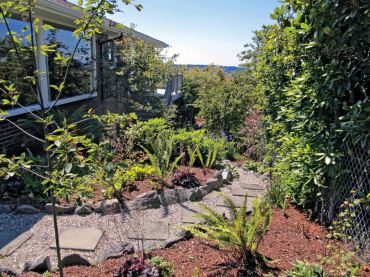
Updating, renovating or simply frustrated by boredom — pondering plants and garden spaces is something all gardeners do at some point. Gardens grow and change and need editing now and then.
Like with many projects, when looking at gardens too long, it is easy to become jaded by bothersome things like weeds taking over a bed or mossy, infested grass. It helps to look at the garden with fresh eyes or have someone take a second look to really make out the whole picture. Sometimes the answer to the design dilemma is right in front of you. It means you need to look at other details, like why the bright-blue garbage can steals the focus from a beautiful tree just beyond or how the line of the lawn is making the flower border look cluttered and messy.
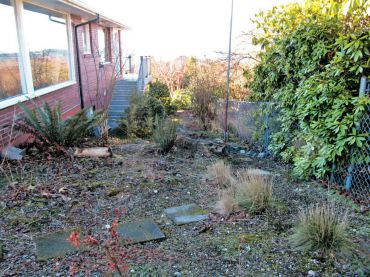
Become a visitor in your own garden. Walk around with pen and paper; bring your camera and take photos. Look at details of the whole area instead of being distracted by the darn weeds taking over.
Clutter and chaos, boredom and blah, struggling plants, dry shade, wet lawns, too much work — the list of typical design dilemmas could go on. The nature of a garden can be formidable when thinking through the makeover process. Where to begin?
First things first: Take time to get a critical look at what is going on. Write detailed notes and take pictures. A photograph will expose things you may not have noticed. Identify the real problem first. Make sure the garden is healthy and the soil is alive and keeping plants thriving. If there is poor drainage, fix it. If a plant is in the wrong conditions for its natural growing habits, move it. Do a bit of investigating to make sure the garden is doing well. Repair structures, freshen with paint, remove or repair broken pots, etc. Then take on aspects of plants and design.
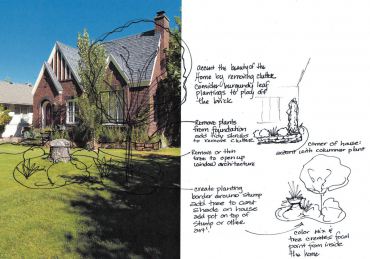
Sometimes the dilemma is a simple fix, like altering a planting border so that the lines have more interest. Start at the ground level and look at borders: Do they simply follow the fence or house foundation without adding interest?
Use landscape paint to spray a temporary new line and take a look at it from inside the home and all views of the garden. Add movement by making the line serpentine to take your focus away from a concrete house foundation and give opportunity to make a planting area join the rest of the landscape. Shape lines so they all connect, much like the dark lines of a coloring book. If they all connect and pathways, driveways or patios are the only breaking point, the landscape will be more interesting and feel complete.
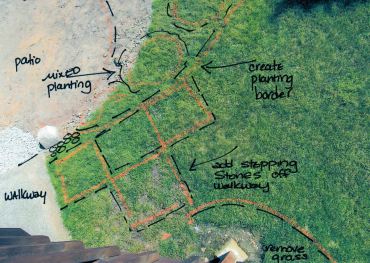
Keep borders between plantings and the lawn clean and defined with an edge that doesn’t waver with thickets of lawn sneaking in. Create a good “mow strip,” which is an edging along the lawn that a lawnmower wheel can easily glide over to catch the grass along the edge. This will keep lines tidy and eliminate the extra work of using a string trimmer.
Is there something to hide? A default question in fixing a dilemma is what you can plant to hide the garbage cans, gain privacy or camouflage the neighbors’ oversized RV. Instead of that sole way of thinking, consider what you can do to add more layers of interest in your view. Move or create a focal point that will distract or turn you away from the undesirable view, then plant appropriately to give a backdrop to the new view.
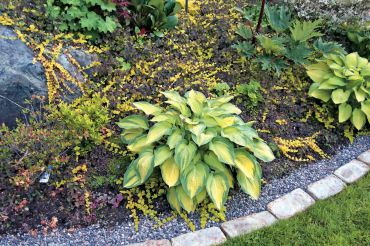
An ugly fence, one of the more frustrating immovable objects of the garden, can become a beautiful boundary with more than just plant additions. Think of it with an interior design point of view, like hanging pictures on a wall. Add trellises, vintage window frames or colorful outdoor art surrounded by planting areas to create a “scene” that is attractive to look at. You will forget all about the unsightly fence.
If a planting area seems dull and boring, many times it is in need of color. An elegant piece of pottery in a planting bed is the color that never goes away and does not need deadheading. Bring unity into color schemes by painting arbors, fences and other structures to blend with the home colors, add plants that will bloom or have leaf color that complements the color tones. Clean up clutter and chaos by creating repetition and harmony. Unify paving stones, patio surfaces and other elements of hardscape with the same style or make of materials. Repeating plants is a good design tool to help borders have a sense of rhythm.
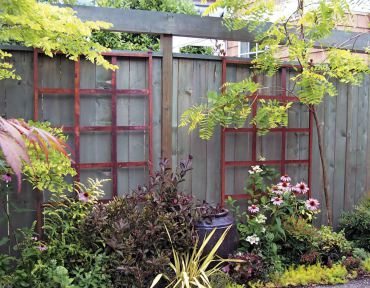
In the process of renovating a garden, keep all seasons in mind. When does the garden look its worst and when does it look its best? Shop for plants that will fill in when the garden is at its worst, such as winter bloomers or late-fall perennials and ornamental grasses.
The next question to consider: When is the garden the most work and when is it the easiest? A summer garden is typically more work. Add low-maintenance and low-water-use plantings. Remove areas of lawn that struggle or are odd angles and hard to mow. If you have a spot where you need to keep grass, replace or renovate it. Make sure the grass is naturally healthy to thrive in wet and dry season, without a reliance on heavy chemicals.
Remember the saying “right plant, right place.” Remove overgrown shrubs along home foundations to help the architecture of the home emerge into the landscape design. Choose plant varieties that will thrive in the conditions and grow to the proper size and space. It is never a good idea to assume you will have time or energy to keep something trimmed if it has the possibility of outgrowing its space.
The process of working through a design dilemma doesn’t always start with a trip to the plant store. Get started by thinking through things first:
- What are the needs of the space? Privacy, entry, declutter, camouflage?
- Can I fix or repair a problem first, then design around it?
- What is missing? Color, pathways, interesting shapes and lines?
- Does the landscape make a connection to the house? Color, texture, style?
- What are the cultural conditions? Dry shade, hot sun, wet soil?
These are your starting steps to solving your design dilemmas. Then the fun begins.

































Comments